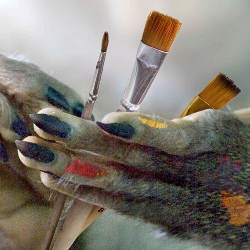
I was on edge going into the interview with my social worker from the Chimera Reassignment Bureau, finally facing the prospect of manumission and full citizenship. Unknown was how I would live up to my new privileges, considering I had been no more than property (by law) my entire life—abandoned property at that.
I was hyperconscious of my appearance, especially around the normals, considering how much I deviated from the baseline. Even among my fellows, in all their telltale variety, I was odd.
My face, covered with fur, like the rest of me, featured eyes proportionately as wide and alert as those of a tarsier, with acute night vision, due to syntho-geno-pheno design. Much of my remaining facial area was dominated by a prehensile snout as pointy as a tapir’s. I sported fangs, despite being herbivorous, also by design. Tall supersensitive omnidirectional ears like a jackrabbit’s sprouted from somewhere above my eyes. My expressive tail forked three-quarters of the way down its hyperarticulated length, the better to dangle from tree limbs when picking fruit, rendering me relatively self-sufficient, also by design. However, my most distinctive (and problematic) feature, especially in light of my professional ambition, were my hands, which were really just big paws, like a leopard’s, no more capable of sewing a stitch than the pincers of a mindless bot crushing ore in an open pit.
Seated now, surrounded by my fellow chimeras, all clearly rendered by the hands of undisciplined bio-hackers, I despaired of ever being understood or achieving my dream of producing art on canvas through a brush or on screen through code.
My mood was lifted a bit by the sound of a springy one-wheeled bot sing-song calling my name and ushering me into an office. In these tight quarters I could smell my own anxiety, despite the aroma having been pre-bioengineered to overcome any potential social revulsion, especially among the normals. My social worker took no notice, not even a wrinkled nose, standing instead to shake my hands, such as they were.
"Nibbles," she said, "I’m here to spell out your new rights and responsibilities and enroll you in the programs that will help you transition to productive citizenship among the normal population." That is, at least they’ll ignore me, I thought, mercifully.
She read me the text of the National Chimera Emancipation Act—I had read it myself a hundred times already—pinch-poked and swiped through a series of augmented-reality presentations with me, then asked the question I had been dreading:
"So, Nibbles, what kind of career and gainful employment do you see for yourself, given your aptitudes?"
"I want to be a painter," I said confidently.
"You mean, like houses?," she said, "but that’s a job for bots—"
"No, like a real artist, like Goya or Picasso or Wyeth. It’s already programmed into my synthetic neural circuits, awaiting activation all this time. I see the image before brush touches canvas. Such colors, such compositions. But, there are these…" I held out my paws.
She looked dubious but not without hope. "Well, under the law, we do offer surgical modification of preexisting conditions. But first let’s analyze your genome and physiology."
Later, presented with the Department’s report, my dreams crumbled again.
"According to the report," the social worker said, "you shouldn’t even be alive. Your cells exhibit six different suites of synthetic amino acids, arrayed in triple-helix form, with a dozen encoding and transcription systems. Your ribosomes are twice as complex as baseline standards, and you have not one but three enteric nervous systems, not to mention multiple distributed ganglia. The geneticists say any kind of hand transplant would be rejected, no matter what kind of immunosuppressive therapy they could provide."
"There’s no hope then?" I said, venting a modest honk from my sniffling snout.
Her face assumed the determined expression of the lead soldier in Frederic Remington’s "The Cavalry Charge." "Easy, Nibbles," she said, "perhaps we can track down your original bioengineer…"
"But," I said, "he lost interest the moment he consigned me to the administrators. I don’t even know his name."
"Leave that to the forensic analysts," she said. "They can follow any bio- or neurological clue, even those embedded in your deepest synthetic unconscious."
They were indeed able to locate him at his facility intently reengineering a synthetic mycoplasma genome, though his hobby was and always would be creating chimeras like me.
Our reunion was in the Bureau’s clinical center where my fear now turned to anger. He expressed no regret for making me the way he did or for sending me away. He said only, "Those ears. What could I have been thinking? I do like the paws, though. Shame they have to go."
My most distinctive (and problematic) feature, especially in light of my professional ambition, were my hands, which were really just big paws, like a leopard’s, no more capable of sewing a stitch than the pincers of a mindless bot crushing ore in an open pit.
But, but… that means I can have real hands instead?
I awoke following the surgery to find they blended nicely with the rest of my otherwise cobbled appearance. Not quite human—a raccoon would be proud—but refined enough to hold a brush and palette, of proper scale.
Now, on the eve of my first solo show, I, your humble Nibbles, recall my early despair with mixed feelings. Who would have imagined my very own social worker would consent to pose for my now-acclaimed portrait, "Naked Maja—With Horns," sold already for more than my board-certified bioengineer makes in even a good year.



Join the Discussion (0)
Become a Member or Sign In to Post a Comment